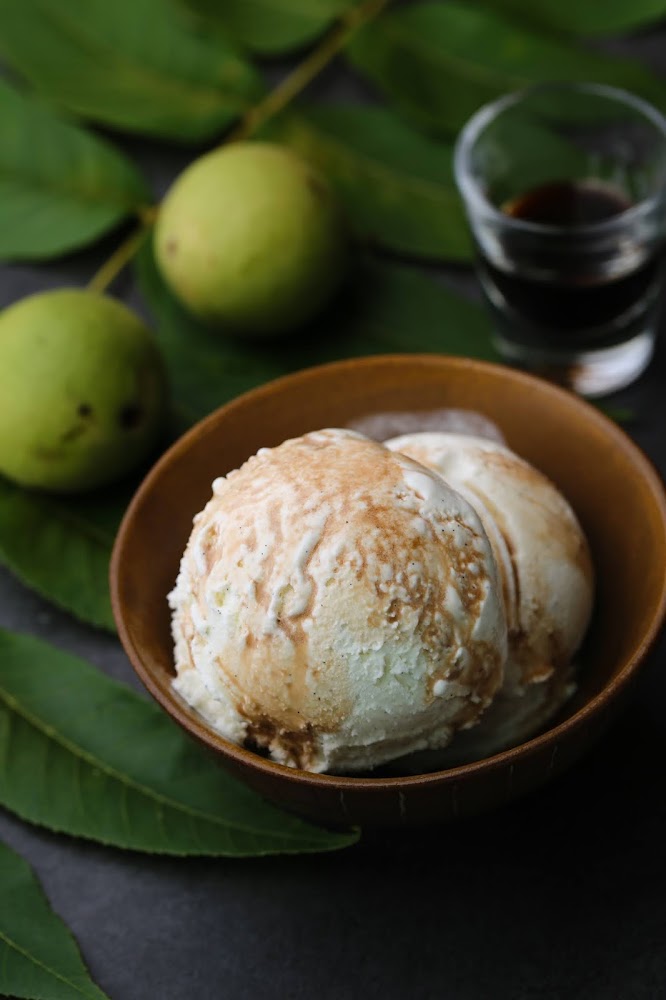Nocino – Black Walnut Liqueur
It's time to make nocino — also known as black walnut liqueur. This dark, sticky drink comes from Italy, and so far, has been the easiest way I've found to use the abundance of black walnuts that grow all over eastern Nebraska. Shelling black walnuts for its meat is an intensive, messy process, so it's no wonder why it's so expensive to buy at the store.
The green and yellow outer layer turns black as soon as it's exposed to air, and it stains like nothing I've seen before. When working with black walnuts, wear gloves and clothes that you wouldn't mind sacrificing. Also process them outside, if possible, as any splattering might stain appliances and kitchen walls.
This recipe works best with young, smaller fruit of early summer, which are easier to split open. You can use older, bigger fruit, as shown in the photos, but they were a pain to crack open since the inner shell had too much time to mature and harden. I had to use a meat mallet, a cleaver and some violence to get into those suckers. I still have brown splatter stains above my kitchen counter.
The base recipe for nocino is simply walnuts, sugar and vodka — the remaining ingredients are additions to add complexity, so experiment to taste. If you don't like the taste of licorice, skip the star anise, though it adds a nice dimension to the liqueur.
This drink is potent, best served chilled as a small night cap or digestif. Or, pour a shot over vanilla ice cream, which makes a unique dessert. If you find the taste of nocino too intense, enjoying it over ice cream is the way to go – the creamy, vanilla flavor softens up the liqueur and complements this spicy drink well.
Nocino keeps well in a dark, cool place and does mellow out after a year. If you care about the appearance of your carpet and furniture, don't serve this drink to the clumsy and careless.
Ingredients:
- 22 green black walnuts- 1 vanilla bean, cut open lengthwise
- 2 cinnamon sticks, broken in half
- Zest from 1 orange, peeled into large strips
- Zest from 1 lemon, peeled into large strips
- 1 star anise
- 4 whole cloves
- 1 cup of real maple syrup
- 1¾ cup of raw sugar
- 1 liter of 80 proof vodka
Special equipment: gallon-size glass jar, disposable gloves and disposable cutting board liner (optional)
Directions:
1. With a cleaver, cut/crack open walnuts in halves or fourths. This is much easier with younger, more tender walnuts; the ones we picked at the end of summer had time to develop that hard shell that was difficult to open.
Wear gloves when handling walnuts and use a liner on wooden or plastic cutting boards.
I suggest you work outside, but if you need to do this indoors, cover surrounding work areas with plastic wrap to avoid staining from splattering juices. When exposed to air, walnut juice turns black quickly and it STAINS. Keep an eye out and wipe off surfaces quickly.
2. Drop cut walnuts into a gallon-size glass jar. Add the rest of the ingredients; vodka should cover all the ingredients completely. Stir or shake the jar to incorporate ingredients.
Store in a cool, dark place for 6 weeks. Shake or stir the jar occasionally to make sure sugar dissolves. The liqueur will quickly go from translucent to opaque and black.
3. After 6 weeks,very carefully (beware of the STAINS!) strain the liqueur through several layers of cheesecloth and discard solids. Transfer liqueur to glass bottles.
Several online sources, including David Lebovitz and Elise Bauer, have said that nocino will be bitter at first but will mellow out as time passes. Elise at Simply Recipes writes that nocino is best drank a year after bottling. It can last several years if stored in a cool, dry place.
Before serving, gently and carefully upend the bottle to distribute any settled syrup/sugar. Make sure your bottle is well sealed before doing this.




Comments
Post a Comment
Feel free to post any questions or comments.